Developer Guide
- Acknowledgements
- Setting up, getting started
- Design
- Implementation
- Documentation, logging, testing, configuration, dev-ops
- Appendix: Planned Enhancements
-
Appendix: Requirements
- Product scope
- Coach stories
-
Use cases
- Use case UC01 - Ask for help
- Use case UC02 - Add an athlete to the contact list
- Use case UC03 - Delete an athlete from the contact list
- Use case UC04 - Edit an athlete’s details
- Use case UC05 - Find an athlete in the contact list
- Use case UC06 - List all athletes in the contact list
- Use case UC07 - Clear the contact and session lists
- Use case UC08 - Sort the contact list by a specified attribute, in ascending order.
- Use case UC09 - Show all athletes belonging to one or more tags.
- Use case UC10 - Undo a command
- Use case UC11 - Redo a command
- Use case UC12 - Add tags to an athlete
- Use case UC13 - Remove tags from an athlete
- Use case UC14 - Add a session to the session list
- Use case UC15 - Delete a session from the session list
- Use case UC16 - Mark an athlete as present for a session
- Use case UC17 - Mark an athlete as absent for a session
- Use case UC18 - Add an athlete to a session
- Use case UC19 - Remove an athlete from a session
- Use case UC20 - View calendar events
- Non-Functional Requirements
- Glossary
- Appendix: Instructions for manual testing
Acknowledgements
- Undo/redo feature implementation concept from original AddressBook 3 Developer Guide.
- Calendar feature implementation adapted from this JavaFX guide.
Setting up, getting started
Refer to the guide Setting up and getting started.
Design
.puml files used to create diagrams in this document can be found in the diagrams folder. Refer to the PlantUML Tutorial at se-edu/guides to learn how to create and edit diagrams.
Architecture

The Architecture Diagram given above explains the high-level design of the App.
Given below is a quick overview of main components and how they interact with each other.
Main components of the architecture
Main has two classes called Main and MainApp. It is responsible for,
- At app launch: Initializes the components in the correct sequence, and connects them up with each other.
- At shut down: Shuts down the components and invokes cleanup methods where necessary.
Commons represents a collection of classes used by multiple other components.
The rest of the App consists of four components.
-
UI: The UI of the App. -
Logic: The command executor. -
Model: Holds the data of the App in memory. -
Storage: Reads data from, and writes data to, the hard disk.
How the architecture components interact with each other
The Sequence Diagram below shows how the components interact with each other for the scenario where the Coach issues the command delete 1.

Each of the four main components (also shown in the diagram above),
- defines its API in an
interfacewith the same name as the Component. - implements its functionality using a concrete
{Component Name}Managerclass (which follows the corresponding APIinterfacementioned in the previous point.)
For example, the Logic component defines its API in the Logic.java interface and implements its functionality using the LogicManager.java class which follows the Logic interface. Other components interact with a given component through its interface rather than the concrete class (reason: to prevent outside component’s being coupled to the implementation of a component), as illustrated in the (partial) class diagram below.

How the Logic component works during the user’s interaction with the Calendar:
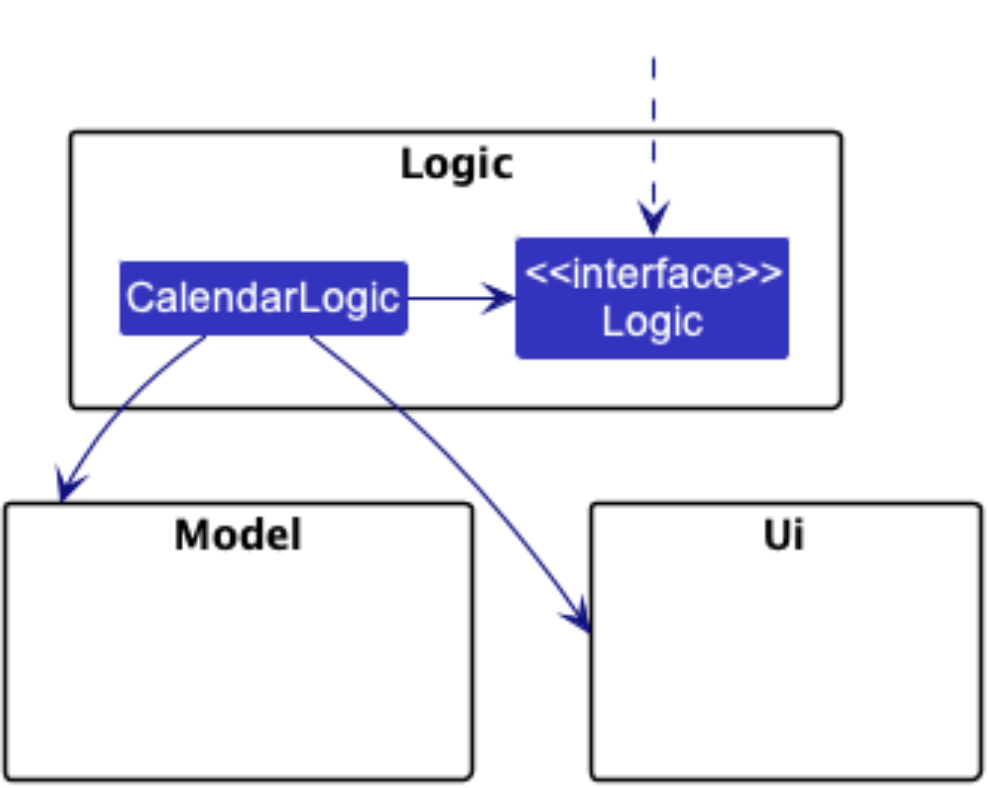
CalendarLogic listens to any changes in Model’s filteredSessionList, which contains different instances of Session, upon interaction with the Calendar UI.
CalendarLogic will then update the corresponding Calendar components in Ui that are dependent on the CalendarEvent.
The sections below give more details of each component.
UI component
The API of this component is specified in Ui.java

The UI consists of a MainWindow that is made up of parts e.g.CommandBox, ResultDisplay, PersonListPanel, StatusBarFooter etc. All these, including the MainWindow, inherit from the abstract UiPart class which captures the commonalities between classes that represent parts of the visible GUI.
The UI component uses the JavaFx UI framework. The layout of these UI parts are defined in matching .fxml files that are in the src/main/resources/view folder. For example, the layout of the MainWindow is specified in MainWindow.fxml
The UI component,
- executes Coach commands using the
Logiccomponent. - listens for changes to
Modeldata so that the UI can be updated with the modified data. - keeps a reference to the
Logiccomponent, because theUIrelies on theLogicto execute commands. - depends on some classes in the
Modelcomponent, as it displaysathleteobject residing in theModel.
Logic component
API : Logic.java
Here’s a (partial) class diagram of the Logic component:

How the Logic component works:
- When
Logicis called upon to execute a command, it uses theAddressBookParserclass to parse the Coach command. - This results in a
Commandobject (more precisely, an object of one of its subclasses e.g.,AddCommand) which is executed by theLogicManager. - The command can communicate with the
Modelwhen it is executed (e.g. to add an athlete). - The result of the command execution is encapsulated as a
CommandResultobject which is returned fromLogic.
The Sequence Diagram below illustrates the interactions within the Logic component for the execute("delete 1") API call.
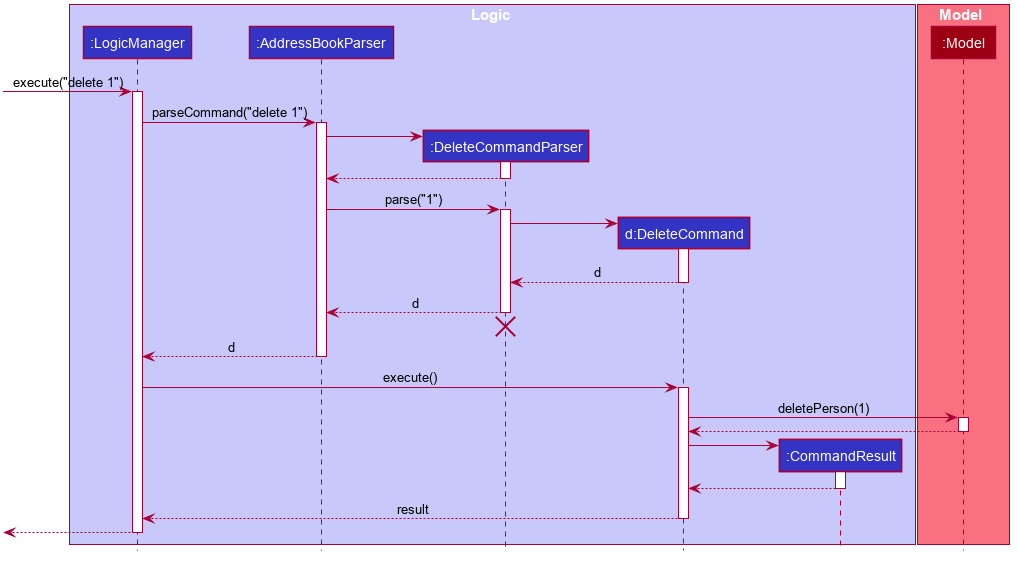
DeleteCommandParser should end at the ‘destroy’ marker (X) but due to a limitation of PlantUML, the lifeline reaches the end of diagram.
Here are the other classes in Logic (omitted from the class diagram above) that are used for parsing a Coach command:

How the parsing works:
- When called upon to parse a Coach command, the
AddressBookParserclass creates anXYZCommandParser(XYZis a placeholder for the specific command name e.g.,AddCommandParser) which uses the other classes shown above to parse the Coach command and create aXYZCommandobject (e.g.,AddCommand) which theAddressBookParserreturns back as aCommandobject. - All
XYZCommandParserclasses (e.g.,AddCommandParser,DeleteCommandParser, …) inherit from theParserinterface so that they can be treated similarly where possible e.g, during testing.
Model component
API : Model.java

The Model component,
- stores SportSync’s data i.e., all
PersonandSessionobjects (which are contained in aUniquePersonListandUniqueSessionListobject respectively). - stores the currently ‘selected’
Personobjects (e.g., results of a search query) as a separate filtered list which is exposed to outsiders as an unmodifiableObservableList<Person>that can be ‘observed’ e.g. the UI can be bound to this list so that the UI automatically updates when the data in the list change. - stores a
UserPrefobject that represents the Coach’s preferences. This is exposed to the outside as aReadOnlyUserPrefobjects. - does not depend on any of the other three components (as the
Modelrepresents data entities of the domain, they should make sense on their own without depending on other components)
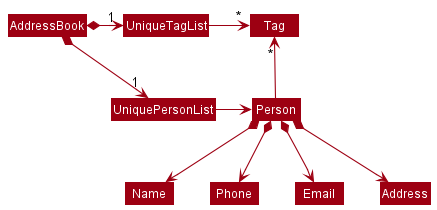
The AddressBook component, contained under Model is responsible for supporting the main functionalities of our app. Mainly the Person class facilitates that contact list functionality, while the Session class
facilitates the scheduling, calendar and data Analytics functionality.
Storage component
API : Storage.java

The Storage component,
- can save both SportSync’s data and user preference data in json format, and read them back into corresponding objects.
- inherits from both
AddressBookStorageandUserPrefStorage, which means it can be treated as either one (if only the functionality of only one is needed). - depends on some classes in the
Modelcomponent (because theStoragecomponent’s job is to save/retrieve objects that belong to theModel)
Common classes
Classes used by multiple components are in the seedu.AddressBook.commons package.
Implementation
This section describes some noteworthy details on how certain features are implemented.
Sort feature
Implementation
The proposed sort mechanism is facilitated by UniquePersonList.
Step 1. The Coach launches the application for the first time. The AddressBook is initialised.
Step 2. The Coach keys in some athletes and their details with the add method.
Step 3. After adding his athletes, the Coach wants to view his athletes in alphabetical order, so he wants to sort them by name in ascending order.
Step 4. The Coach then decides to execute the command sort 1.
Design considerations:
Restricting attribute and order to an integer value allows for the input to be easily anticipated and controlled.
-
Alternative 1 (current choice): Allow Coaches to specify how to sort their list by integer.
- Pros: Easier to implement in the code and faster to type by the Coach.
- Cons: More troublesome as Coach needs to check the User Guide to learn what integers to use.
-
Alternative 2: Allow Coaches to specify how to sort their list by words.
- Pros: Easier to understand by the Coach.
- Cons: Harder to implement in the code and slower to type by the Coach.
Undo/redo feature
Implementation
The proposed undo/redo mechanism is facilitated by VersionedAddressBook. It extends AddressBook with an undo/redo history, stored internally as an addressBookStateList and currentStatePointer. Additionally, it implements the following operations:
-
VersionedAddressBook#commit()— Saves the currentAddressBookstate in its history. -
VersionedAddressBook#undo()— Restores the previousAddressBookstate from its history. -
VersionedAddressBook#redo()— Restores a previously undoneAddressBookstate from its history.
These operations are exposed in the Model interface as Model#commitAddressBook(), Model#undoAddressBook() and Model#redoAddressBook() respectively.
Given below is an example usage scenario and how the undo/redo mechanism behaves at each step.
Step 1. The Coach launches the application for the first time. The VersionedAddressBook will be initialized with the initial AddressBook state, and the currentStatePointer pointing to that single AddressBook state.
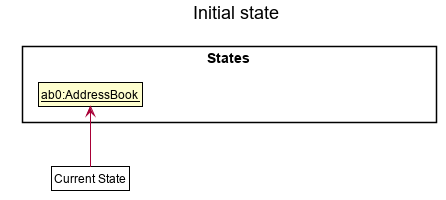
Step 2. The Coach executes delete 5 command to delete the 5th athlete in the AddressBook. The delete command calls Model#commitAddressBook(), causing the modified state of the AddressBook after the delete 5 command executes to be saved in the AddressBookStateList, and the currentStatePointer is shifted to the newly inserted AddressBook state.
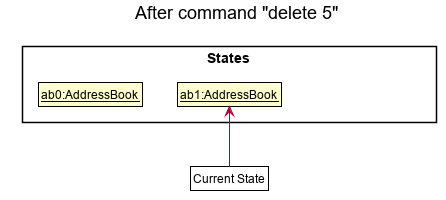
Step 3. The Coach executes add n/David … to add a new athlete. The add command also calls Model#commitAddressBook(), causing another modified AddressBook state to be saved into the AddressBookStateList.
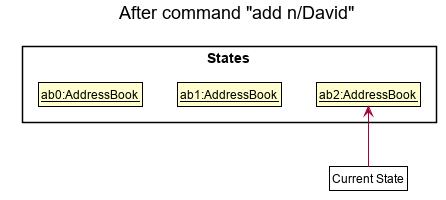
Model#commitAddressBook(), so the AddressBook state will not be saved into the AddressBookStateList.
Step 4. The Coach now decides that adding the athlete was a mistake, and decides to undo that action by executing the undo command. The undo command will call Model#undoAddressBook(), which will shift the currentStatePointer once to the left, pointing it to the previous AddressBook state, and restores the AddressBook to that state.
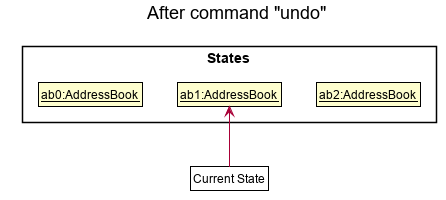
currentStatePointer is at index 0, pointing to the initial AddressBook state, then there are no previous AddressBook states to restore. The undo command uses VersionedAddressBook#canUndo() to check if this is the case. If so, it will return an error to the Coach rather
than attempting to perform the undo operation.
The following sequence diagram shows how the undo operation works:
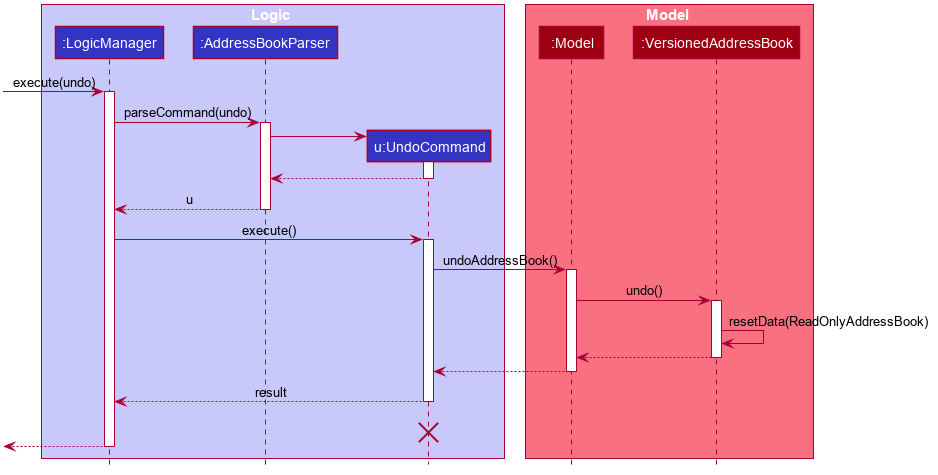
UndoCommand should end at the ‘destroy’ marker (X) but due to a limitation of PlantUML, the lifeline reaches the end of diagram.
The redo command does the opposite — it calls Model#redoAddressBook(), which shifts the currentStatePointer once to the right, pointing to the previously undone state, and restores the AddressBook to that state.
currentStatePointer is at index AddressBookStateList.size() - 1, pointing to the latest AddressBook state, then there are no undone AddressBook states to restore. The redo command uses VersionedAddressBook#canRedo() to check if this is the case. If so, it will return an error to the Coach rather than attempting to perform the redo.
Step 5. The Coach then decides to execute the command list. Commands that do not modify the AddressBook, such as list, will usually not call Model#commitAddressBook(), Model#undoAddressBook() or Model#redoAddressBook(). Thus, the AddressBookStateList remains unchanged.
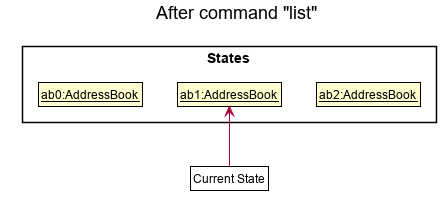
Step 6. The Coach executes clear, which calls Model#commitAddressBook(). Since the currentStatePointer is not pointing at the end of the AddressBookStateList, all AddressBook states after the currentStatePointer will be purged. Reason: It no longer makes sense to redo the add n/David … command. This is the behavior that most modern desktop applications follow.

The following activity diagram summarizes what happens when a Coach executes a new command:
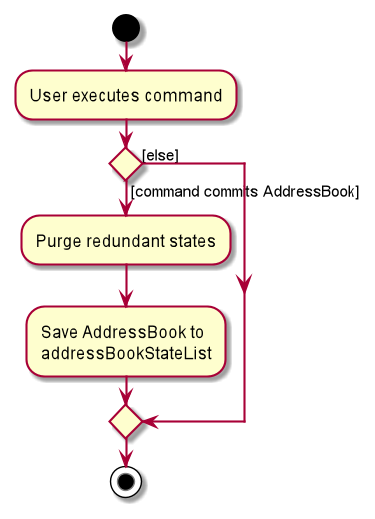
Design considerations:
Aspect: How undo & redo executes:
-
Alternative 1 (current choice): Saves the entire
AddressBook.- Pros: Easy to implement.
- Cons: May eventually have performance issues in terms of memory usage.
-
Alternative 2: Individual command knows how to undo/redo by
itself.
- Pros: Will use less memory (e.g. for
delete, just save thePersonbeing deleted). - Cons: We must ensure that the implementation of each individual command are correct.
- Pros: Will use less memory (e.g. for
Session feature
Implementation
The proposed session feature is facilitated by a Session, contained in a UniqueSessionList, which is subsequently contained an AddressBook.
It supports the following sub-features:
- Adding/Removing athletes from a
Session - Taking the attendance of an athlete in a
Session - Data Analytics
To better understand how each sub-feature is implemented, we need to have a better picture of the attributes of Session object.

As seen above, a Session needs a:
-
SessionName: to uniquely identify aSession -
Location: extra information for the Coach -
AttendanceMap: to store references of participating athletes -
PayRateMap: to support the Data Analytics functionality
The Session object implements the following operations to enable the respective sub-features:
Adding/Removing athletes from a session
-
Session#addPersonToSession()— Adds aPersonreference to aSessionobject’sAttendanceMap. -
Session#removePersonFromSession()— Removes aPersonreference from aSessionobject’sAttendanceMap.
Taking the attendance of an athlete in a session
-
Session#markStudentPresent()— setPersonreference in aSessionobject’sAttendanceMapas present. -
Session#markStudentAbsent()— setPersonreference in aSessionobject’sAttendanceMapas absent.
These operations are exposed in the Model interface as Model#addPersonToSession(), Model#removePersonFromSession() and Model#setSession().
Given below is an example usage scenario and for each sub-feature:
Adding/Removing athletes from a session
To enable this feature, we need to have a data structure that can store references to athletes in a Session. A naive way to do this would be to have a UniquePersonList in a Session object. However, since we also need to track the attendance of every athlete, we propose using a HashMap class to store key-value pairs where the key is a String (the athlete’s name), and the value is a Boolean (to indicate attendance).
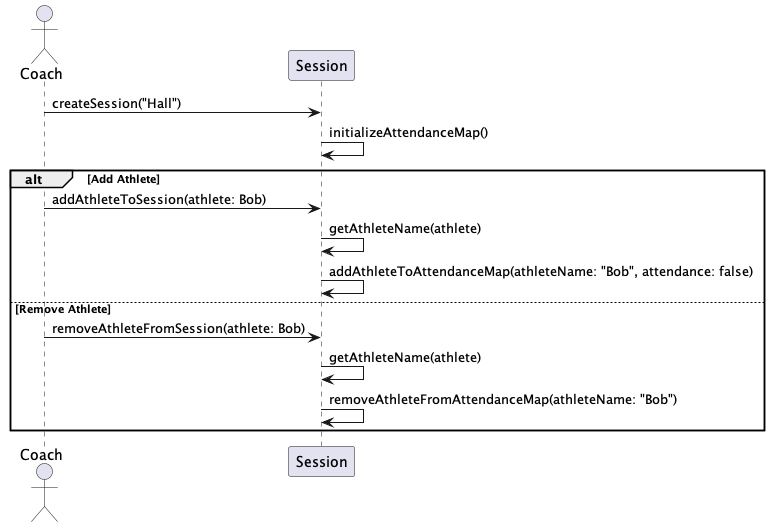
Step 1. The coach decides to create a new Session object named “Hall”. A session is initialized, creating an empty AttendanceMap.
Step 2. The coach decides to add athlete Bob (a Person object) to the Hall Session.
- We first find the
Nameof Bob and convert it to itsStringequivalent. - We then insert a key-value pair of
String: “Bob” andBoolean:falseinto ourAttendanceMap. - We now have a reference to athlete Bob in our
AttendanceMapin theSession. - Note that attendance is set to
falseby default since the session hasn’t started yet.
Step 3. Bob decides to quit the Session, and the coach decides to remove Bob from the Hall Session.
- We first find the
Nameof Bob and convert it to itsStringequivalent. - We then check our
AttendanceMapto make sure Bob is an existing athlete, i.e., an existing key in theHashMap. - We then remove the key of
String: “Bob” from ourAttendanceMap. - We no longer have a reference to Bob in our Hall
Sessionobject.
Taking Attendance of an Athlete in a Session
Similar to adding/removing athletes, marking/unmarking the attendance of an athlete relies on the AttendanceMap object.

Marking and unmarking an athlete undergo the same steps, with the only difference being that marking sets the value of the key as true, while unmarking sets it to false. Here’s an example scenario where the coach decides to mark Bob as present in the Hall Session object:
Step 1. We check if Bob is a key in the AttendanceMap of Hall.
Step 2. We then set the key using the HashMap#put() method to set the value of the key Bob as true.
Generating Data Analytics for a Coach
Our data analytics feature currently supports the following statistics for our coach:
- Daily earnings
- Weekly earnings
- Monthly earnings
- All-time earnings
These statistics are implemented with the help of the PayRateMap in the Session class, which maps all participating athletes with their PayRate. Note that PayRate is a float indicating the hourly rate an athlete would pay the Coach.
Since we are not storing full Person objects in a Session, we cannot find an athlete’s Payrate by simply calling a method in the Session itself. The only thing stored in AttendanceMap is the athlete’s name. Therefore, we need to access the UniquePersonList in the AddressBook class to find the Payrate.
The Session class uses the getTotalPay() method to find the total Payrate of all athletes in the Session. This method follows a set formula.
To find the daily, weekly, and monthly earnings, we iterate through our UniqueSessionList and find all instances of Session that fall between a specified period.
Calendar features
The calendar feature allows a calendar to display with the corresponding Session instances of the month in a calendar format. The feature consists of the following features:
-
Calendar Display- Can display appointments of a month in a calendar format. -
Calendar Navigation- Can navigate between months with/without a mouse. -
Calendar Pop-Up- Can view the details of each appointment.
Overall implementation of Calendar
The main calendar display is implemented using the CalendarDisplay class, which acts as the main container for the entire Calendar feature. This main container consists of a topCalendar, which is a FlowPane that contains the current month to be displayed, and the different navigation buttons as well as the JumpBox. Also, CalendarDisplay contains calendarGrid, which is a GridPane that contains all the dates and Appointment buttons within the calendar.
Upon initialisation of the CalendarDisplay, it will display the current month and year, using the CalendarLogic#drawCalendar() method. The current month and year is obtained using the default Java package’s GregorianCalendar class.
Calendar Display
Implementation:
The following is a more detailed explanation on how Calendar Display is implemented:
- When the app first launches,
MainWindow#fillInnerParts()is called, which then initialises theCalendar Display. - The
CalendarLogicclass is initialised, where the current month to be displayed in theCalendaris set usingJava’sGregorianCalendarclass. - Next,
CalendarLogic#drawCalendar()is called which initialises the header of theCalendar, by callingCalendarLogic#drawHeader(), where theFlowPane,topCalendar, displays the current month. - Also,
CalendarLogic#drawCalendar()will then callCalendarLogic#drawBody()which initialise the body of theCalendarand each individual day of the month is created in theCalendar. - A
CalendarEventListPanelobject is created for each day of the month, andEventButtonsare added to eachCalendarEventListPanelif there is an appointment falling on that particular day. - Following which, when appointments are added,
Model#updateCalendarEventList()is called which then updates theCalendar Displayas well.
Calendar Navigation
The Calendar navigation allows a user to navigate between different months in the calendar and also navigate between the different appointments within the current month, by clicking on the Next/Prev buttons to view the next/previous month in the calendar.
Calendar Pop-up
The calendar Pop-up allows user to view the details of the appointment in the calendar.
These are the ways that a user can use the Calendar Pop-up feature:
- Clicking on the Up/Down/Left/Right keys to view adjacent instances of
Sessionoriented in space in the calendar after selecting oneSession - Clicking on a desired appointment to view the
Sessionin the calendar.
Documentation, logging, testing, configuration, dev-ops
Appendix: Planned Enhancements
-
The names of the individual tag and session-related commands are inconsistent.
For example, creating a new athlete usesadd, while a new session usescreate-session, and adding an athlete to a session usesstudent-add.
We plan on standardising the names toadd,add-session, andadd-athleteto avoid confusion. -
UI inconsistencies may not be user-friendly.
This is especially the case when the message is long (i.e. an error message).
We plan on adjusting the app UI such that the features scale according to the size of the window, including the output box which will display its entire contents without needing to scroll through it. -
The app cannot be navigated solely through keyboard input alone.
Mouse clicks are still required to select an athlete/session even after using keyboard shortcuts to switch tabs. This may make it inconvenient for those who may prefer CLI apps.
We plan on making the app completely navigable through keyboard input while also allowing one to click parts of the GUI. -
Once created, a session cannot be edited.
This makes it inconvenient for the user when they mistakenly create a session with the wrong details. Hence, we plan on adding asession-editcommand.
This will allow users to edit created sessions and not have to create new ones entirely. -
More error messages could be added to cover all possible invalid inputs.
When entering a wrongly formatted command, SportSync displays a generic message stating that the command format is wrong.
We plan on adding more error messages that precisely state how the command format is wrong, to improve user understanding.
e.g. “Wrong command format: Datetime should be in format DD-MM-YYYY HH:mm” -
Session panel user experience could be improved.
Currently, the sessions in the session panel need to stay selected to see their analytics.
If the user clicks the command box while a session is selected, the analytics are cleared.
We plan on making the analytics stay present at all times unless when clicking and selecting a different session so users can better reference their analytics. -
Help command could be more helpful.
Help command only opens a window for users to copy a link to the User Guide.
We plan on making the help command display all possible user command formats so the user does not need to exit the app to find help.
Appendix: Requirements
Product scope
Target Coach profile: Sports Coaches
- has a need to manage a significant number of athletes.
- prefer desktop apps over other types.
- can type fast.
- prefers typing rather than mouse interaction.
- is reasonably comfortable using CLI (Command Line Interface) apps.
- requires organising their coaching schedule on a frequent basis.
Value proposition:
- manage contacts faster than a typical mouse/GUI-driven app.
- features are geared towards managing athletes.
- makes scheduling of training sessions more convenient than a regular calendar app.
Coach stories
Priorities:
High (must have) - * * *
Medium (nice to have) - * *
Low (unlikely to have) - *
| Priority | As a … | I want to … | So that I can… |
|---|---|---|---|
* * * |
new Coach | see usage instructions | refer to instructions when I forget how to use the app |
* * * |
Coach | add a new athlete | record their profile |
* * * |
Coach | delete an athlete | remove athletes that I no longer train |
* * * |
Coach | edit an athlete’s details | refer to accurate information regarding that athlete |
* * |
Coach | find an athlete by name | locate details of an athlete without having to go through the entire list |
* * |
Coach | hide an athlete’s private contact details | minimize chance of someone else seeing them by accident |
* * |
Coach | organise athletes by groups | facilitate better contact management |
* |
Coach with many athletes | sort athletes by name | locate an athlete easily |
* |
Coach with many training sessions | view my upcoming schedule as a calendar | better plan my week. |
Use cases
Use case UC01 - Ask for help
MSS
- Coach requests for help.
-
SportSync displays a window containing a link to the SportSync User Guide.
Use case ends.
Use case UC02 - Add an athlete to the contact list
Guarantee: A new athlete with specified name, phone number, pay rate, address and at least
one tag is created and added to the contact list.
MSS
- Coach requests to add a new athlete in the contact list.
- Coach adds in the following details:
- Name
- Phone Number
- Pay rate
- Address
- Tag (optional, can be more than one)
-
SportSync adds the athlete.
Use case ends.
Extensions
- 2a. Not enough details of the athlete were given.
- 2a1. SportSync shows an error message with the correct command format.
Use case resumes at step 1.
- 2a1. SportSync shows an error message with the correct command format.
- 2b. An athlete with the same name already exists within the contact list.
- 2b1. SportSync shows an error message telling the Coach that the athlete already exists.
Use case resumes at step 1.
- 2b1. SportSync shows an error message telling the Coach that the athlete already exists.
- 2c. At least one of the details specified is of invalid format.
- 2c1. SportSync shows an error message specifying how the detail is of the wrong format.
Use case resumes at step 1.
- 2c1. SportSync shows an error message specifying how the detail is of the wrong format.
Use case UC03 - Delete an athlete from the contact list
MSS
- Coach requests to delete a specific athlete by providing their index in the contact list.
-
SportSync deletes the athlete.
Use case ends.
Extensions
- 1a. The given index is not a positive integer.
- 1a1. SportSync shows an error message with the correct command format.
Use case resumes at step 1.
- 1a1. SportSync shows an error message with the correct command format.
- 2a. The index given is out of bounds with respect to the size of the contact list.
- 2a1. SportSync shows an error message stating the index is out of bounds.
Use case resumes at step 1.
- 2a1. SportSync shows an error message stating the index is out of bounds.
Use case UC04 - Edit an athlete’s details
MSS
- Coach requests to edit a specific athlete’s details by providing their index in the contact list.
- Coach provides at least one of the following fields to edit:
- Name
- Phone Number
- Pay rate
- Address
- Tag
-
SportSync edits the specified fields.
Use case ends.
Extensions
- 1a. The given index is not a positive integer.
- 1a1. SportSync shows an error message with the correct command format.
Use case resumes at step 1.
- 1a1. SportSync shows an error message with the correct command format.
- 1b. The index given is out of bounds with respect to the size of the contact list.
- 1b1. SportSync shows an error message stating the index is out of bounds.
Use case resumes at step 1.
- 1b1. SportSync shows an error message stating the index is out of bounds.
- 2a. At least one of the edited fields is of invalid format.
- 2a1. SportSync shows an error message specifying how the field is of the wrong format.
Use case resumes at step 1.
- 2a1. SportSync shows an error message specifying how the field is of the wrong format.
Use case UC05 - Find an athlete in the contact list
MSS
- Coach requests to find athletes in the contact list, by name, by providing a keyword.
-
SportSync displays the search results.
Use case ends.
Extensions
- 1a. The given keyword does not correspond to any athlete’s name within the contact list.
- 1a1. SportSync shows no athletes listed in the results.
Use case resumes at step 1.
- 1a1. SportSync shows no athletes listed in the results.
Use case UC06 - List all athletes in the contact list
Guarantee: All athletes in the contact list will be shown.
MSS
- Coach requests to list out all athletes in the contact list.
-
SportSync displays all athletes in the contact list.
Use case ends.
Use case UC07 - Clear the contact and session lists
MSS
- Coach requests to clear all athletes from the contact list, and sessions from the session list.
-
SportSync clears all athletes from the contact list, and sessions from the session list.
Use case ends.
Use case UC08 - Sort the contact list by a specified attribute, in ascending order.
MSS
- Coach requests to sort all athletes in the contact list by a specified attribute, in ascending order.
- Coach provides one of the following integers to signify the attribute to sort by:
- Name
- Pay rate
-
SportSync sorts all athletes in the contact list by the specified attribute, in ascending order.
Use case ends.
Extensions
- 2a. The given integer is not 1 or 2.
- 2a1. SportSync displays an error message.
Use case resumes at step 1.
- 2a1. SportSync displays an error message.
Use case UC09 - Show all athletes belonging to one or more tags.
MSS
- Coach requests to show all athletes belonging to specified tag(s) by name.
- Coach provides one or more tags.
-
SportSync shows all athletes by name, belonging to one or more of the specified tag(s).
Use case ends.
Extensions
- 2a. No tags are given.
- 2a1. SportSync shows an error message with the correct command format.
Use case resumes at step 1.
- 2a1. SportSync shows an error message with the correct command format.
- 2b. One of the tags given do not exist.
- 2b1. SportSync shows an error message stating that the tag does not exist.
Use case resumes at step 1.
- 2b1. SportSync shows an error message stating that the tag does not exist.
Use case UC10 - Undo a command
MSS
- Coach requests to undo a mistakenly entered command.
-
SportSync undoes the mistakenly entered command.
Use case ends.
Extensions
- 1a. An undo operation is not possible as there is nothing left to undo.
- 1a1. SportSync shows an error message stating that there is nothing left to undo.
Use case resumes at step 1.
- 1a1. SportSync shows an error message stating that there is nothing left to undo.
Use case UC11 - Redo a command
- Similar to UC10 but executes a redo operation instead.
Use case UC12 - Add tags to an athlete
MSS
- Coach requests to add one or more tags to an athlete in the contact list by providing their index.
- Coach provides one or more tags to add to the specified athlete.
-
SportSync adds the tag(s) to the athlete.
Use case ends.
Extensions
- 1a. The given index is not valid.
- 1a1. SportSync shows an error message with the correct command format.
Use case resumes at step 1.
- 1a1. SportSync shows an error message with the correct command format.
- 2a. The athlete already has at least one of the specified tags.
- 2a1. SportSync shows an error message stating that the athlete already has one of the tags.
Use case resumes at step 1.
- 2a1. SportSync shows an error message stating that the athlete already has one of the tags.
Use case UC13 - Remove tags from an athlete
MSS
- Coach requests to remove one or more tags to an athlete in the contact list by providing their index.
- Coach provides one or more tags to remove from the specified athlete.
-
SportSync removes the tag(s) from the athlete.
Use case ends.
Extensions
- 1a. The given index is not valid.
- 1a1. SportSync shows an error message with the correct command format.
Use case resumes at step 1.
- 1a1. SportSync shows an error message with the correct command format.
- 2a. One or more of the specified tags do not already belong to the athlete.
- 2a1. SportSync shows an error message stating that the athlete does not have one of the tags.
Use case resumes at step 1.
- 2a1. SportSync shows an error message stating that the athlete does not have one of the tags.
Use case UC14 - Add a session to the session list
- Similar to UC02, but the Coach enters the session name, datetime and location to create a session.
Use case UC15 - Delete a session from the session list
- Similar to UC03 but deletes a session from the session list instead.
Use case UC16 - Mark an athlete as present for a session
MSS
- Coach requests to mark an athlete as present for a session specified by its index.
- Coach provides the athlete’s name to mark as present.
-
SportSync marks the athlete as present in the specified session.
Use case ends.
Extensions
- 1a. The given index is not a positive integer.
- 1a1. SportSync shows an error message with the correct command format.
Use case resumes at step 1.
- 1a1. SportSync shows an error message with the correct command format.
- 1b. The index given is out of bounds with respect to the size of the session list.
- 1b1. SportSync shows an error message stating the index is invalid.
Use case resumes at step 1.
- 1b1. SportSync shows an error message stating the index is invalid.
- 2a. The specified athlete does not belong to the session.
- 2a1. SportSync shows an error message stating that the athlete does not exist in the specified session.
Use case resumes at step 1.
- 2a1. SportSync shows an error message stating that the athlete does not exist in the specified session.
Use case UC17 - Mark an athlete as absent for a session
- Similar to UC16 but marks the athlete as absent instead.
Use case UC18 - Add an athlete to a session
MSS
- Coach requests to add an athlete to a session.
- Coach provides the athlete’s index in the contact list.
- Coach provides the session’s name in the session list.
-
SportSync adds the specified athlete to the specified session.
Use case ends.
Extensions
- 2a. The given index is not a positive integer.
- 2a1. SportSync shows an error message with the correct command format.
Use case resumes at step 1.
- 2a1. SportSync shows an error message with the correct command format.
- 2b. The index given is out of bounds with respect to the size of the contact list.
- 2b1. SportSync shows an error message stating the index is invalid.
Use case resumes at step 1.
- 2b1. SportSync shows an error message stating the index is invalid.
- 3a. The session name given does not exist in the session list.
- 3a1. SportSync shows an error message stating the session does not exist.
Use case resumes at step 1.
- 3a1. SportSync shows an error message stating the session does not exist.
- 3b. The specified athlete already belongs to the specified session
- 3b1. SportSync shows an error message stating the specified athlete already belongs to the specified session.
Use case resumes at step 1.
- 3b1. SportSync shows an error message stating the specified athlete already belongs to the specified session.
Use case UC19 - Remove an athlete from a session
MSS
- Coach requests to remove an athlete from a session.
- Coach provides the athlete’s index in the contact list.
- Coach provides the session’s name in the session list.
-
SportSync removes the specified athlete from the specified session.
Use case ends.
Extensions
- 2a. The given index is not a positive integer.
- 2a1. SportSync shows an error message with the correct command format.
Use case resumes at step 1.
- 2a1. SportSync shows an error message with the correct command format.
- 2b. The index given is out of bounds with respect to the size of the contact list.
- 2b1. SportSync shows an error message stating the index is invalid.
Use case resumes at step 1.
- 2b1. SportSync shows an error message stating the index is invalid.
- 3a. The session name given does not exist in the session list.
- 3a1. SportSync shows an error message stating the session does not exist.
Use case resumes at step 1.
- 3a1. SportSync shows an error message stating the session does not exist.
- 3b. The specified athlete does not already belong to the specified session
- 3b1. SportSync shows an error message stating the specified athlete does not already belong to the specified session.
Use case resumes at step 1.
- 3b1. SportSync shows an error message stating the specified athlete does not already belong to the specified session.
Use case UC20 - View calendar events
MSS
- Coach requests to view the calendar events.
- SportSync displays the calendar events on the interface.
-
Coach interacts with the calendar events as desired.
Use case ends.
Non-Functional Requirements
- Should work on any mainstream OS as long as it has Java
11or above installed. - Should be able to hold up to 1000 athletes without a noticeable sluggishness in performance for typical usage.
- A Coach with above average typing speed for regular English text (i.e. not code, not system admin commands) should be able to accomplish most of the tasks faster using commands than using the mouse.
Glossary
- Mainstream OS: Windows, Linux, Unix, OS-X.
- Private contact detail: A contact detail that is not meant to be shared with others.
- Pay rate: The amount of fees paid by the athlete per session.
- Session: A training period for athletes, conducted by a coach.
- Session List: A list of training sessions.
- Athlete: A person being trained by a coach.
- Contact List: A list of athletes and their contact details.
- Coach: A person who trains and directs athletes or a team.
- Tag: A label attached to an athlete in SportSync.
Appendix: Instructions for manual testing
Given below are some instructions to test some parts of the app manually.
They do not represent the entirety of SportSync’s available functionality, and testers are encouraged to come up with their own tests.
Launch and shutdown
-
Initial launch
-
Download the jar file and copy into an empty folder
-
Double-click the jar file.
Expected: Shows the GUI with a set of sample contacts. The window size may not be optimum.
-
-
Saving window preferences
-
Resize the window to an optimum size. Move the window to a different location. Close the window.
-
Re-launch the app by double-clicking the jar file.
Expected: The most recent window size and location is retained.
-
-
Saving contact and session lists
-
Enter
add n/John Doe p/98765432 a/311, Clementi Ave 2, r/35 t/friends t/owesMoneyto addJohn Doeto your contact list. -
Close the window, then re-launch the app by double-clicking the jar file.
Expected:John Doeremains in the contact list, signifying a successful save. -
Repeat steps 1-2 with
create-session n/Hall s/10-03-2022 10:00 to 10-03-2022 11:00 l/MPSH2to addHallto your session list.
Expected:Hallremains in the session list, signifying a successful save.
-
Deleting an athlete
-
Deleting an athlete while all athletes are being shown
-
Prerequisites: List all athletes using the
listcommand. Multiple athletes in the list. -
Test case:
delete 1
Expected: First contact is deleted from the list. Details of the deleted contact shown in the status message. Timestamp in the status bar is updated. -
Test case:
delete 0
Expected: No athlete is deleted. Error details shown in the status message. Status bar remains the same. -
Other incorrect delete commands to try:
delete,delete x,...(where x is larger than the list size)
Expected: Similar to previous.
-
Saving data
-
Dealing with missing/corrupted data files
-
Prerequisites: Start up SportSync and perform a few commands to ensure
datafolder is present in the same directory assportsync.jar -
Open
datafolder. Then, opensportsync.jsonwith any text editor. -
Delete any row of the code so that the format is no longer consistent. Save the
sportsync.jsonfile. -
Start up SportSync again.
Expected: SportSync should have an empty session list and contact list. -
Add new athletes/sessions and continue using SportSync as per normal.
-